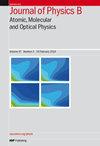Spectroscopy of the 5s5p 3P0 → 5s5d 3D1 transition of strontium using laser cooled atoms
IF 1.5
4区 物理与天体物理
Q3 OPTICS
Journal of Physics B: Atomic, Molecular and Optical Physics
Pub Date : 2024-04-08
DOI:10.1088/1361-6455/ad3bff
引用次数: 0
Abstract
This article presents spectroscopy results of the 5s5p 3P0 → 5s5d 3D1 transition in all isotopes of laser cooled Sr atoms and the utility of this transition for repumping application. By employing the 5s5p 3P0 → 5s5d 3D1 (483 nm) transition in combination with the excitation of 5s5p 3P2 → 5s6s 3S1 (707 nm) transition, we observe a significant increase (∼ 13 fold) in the steady state number of atoms in the magneto-optic trap (MOT). This enhancement is attributed to the efficient repumping of Sr atoms that have decayed into the dark 5s5p 3P2 state by returning them to the ground state 5s2 1S0 without any loss into the other states. The absolute transition frequencies were measured with an absolute accuracy of 30 MHz. To support our measurements, we performed Fock-space relativistic coupled-cluster calculations of the relevant parameters in Sr. To further increase the accuracy of the calculated properties, corrections from the Breit, QED and perturbative triples were also included. The calculated branching ratio for the repumping state confirms the significantly increased population in the 3P1 state. Thereby, leading to an increase of population of atoms trapped due to the enhanced repumping. Our calculated hyperfine-splitting energies are in excellent agreement with the measured values. Moreover, our calculated isotope shifts in the transition frequencies are in good agreement with our measured values.利用激光冷却原子对锶的 5s5p 3P0 → 5s5d 3D1 转变进行光谱分析
本文介绍了激光冷却锶原子所有同位素的 5s5p 3P0 → 5s5d 3D1转变的光谱学结果,以及该转变在再泵送应用中的实用性。通过将 5s5p 3P0 → 5s5d 3D1 (483 nm) 转变与 5s5p 3P2 → 5s6s 3S1 (707 nm) 转变的激发相结合,我们观察到磁光陷阱(MOT)中原子的稳态数量显著增加(∼ 13 倍)。这种增强归因于衰变到暗 5s5p 3P2 态的硒原子被有效地重新泵回基态 5s2 1S0,而没有任何其他态的损耗。绝对转换频率的测量绝对精度为 30 MHz。为了支持我们的测量,我们对 Sr 的相关参数进行了 Fock 空间相对论耦合簇计算。为了进一步提高计算性质的准确性,我们还加入了布雷特、QED 和微扰三重校正。计算得出的再泵送态分支率证实了 3P1 态的种群数量显著增加。因此,由于增强的回射作用,被困原子的数量也随之增加。我们计算出的超正则分裂能与测量值非常吻合。此外,我们计算出的过渡频率同位素偏移与测量值也非常吻合。
本文章由计算机程序翻译,如有差异,请以英文原文为准。
求助全文
约1分钟内获得全文
求助全文
来源期刊
CiteScore
3.60
自引率
6.20%
发文量
182
审稿时长
2.8 months
期刊介绍:
Published twice-monthly (24 issues per year), Journal of Physics B: Atomic, Molecular and Optical Physics covers the study of atoms, ions, molecules and clusters, and their structure and interactions with particles, photons or fields. The journal also publishes articles dealing with those aspects of spectroscopy, quantum optics and non-linear optics, laser physics, astrophysics, plasma physics, chemical physics, optical cooling and trapping and other investigations where the objects of study are the elementary atomic, ionic or molecular properties of processes.

 求助内容:
求助内容: 应助结果提醒方式:
应助结果提醒方式:


